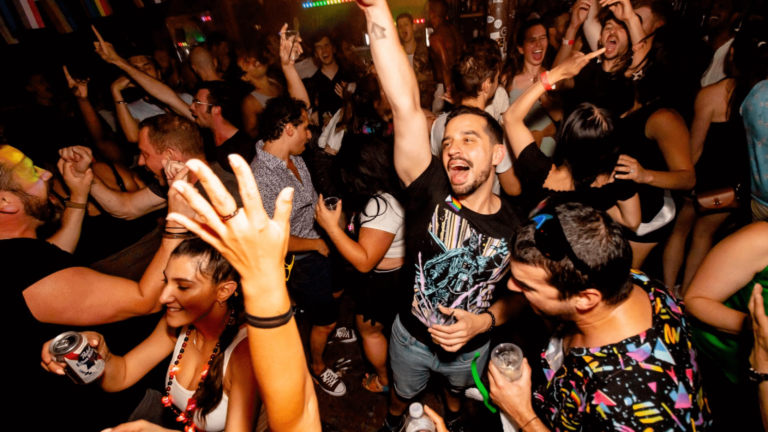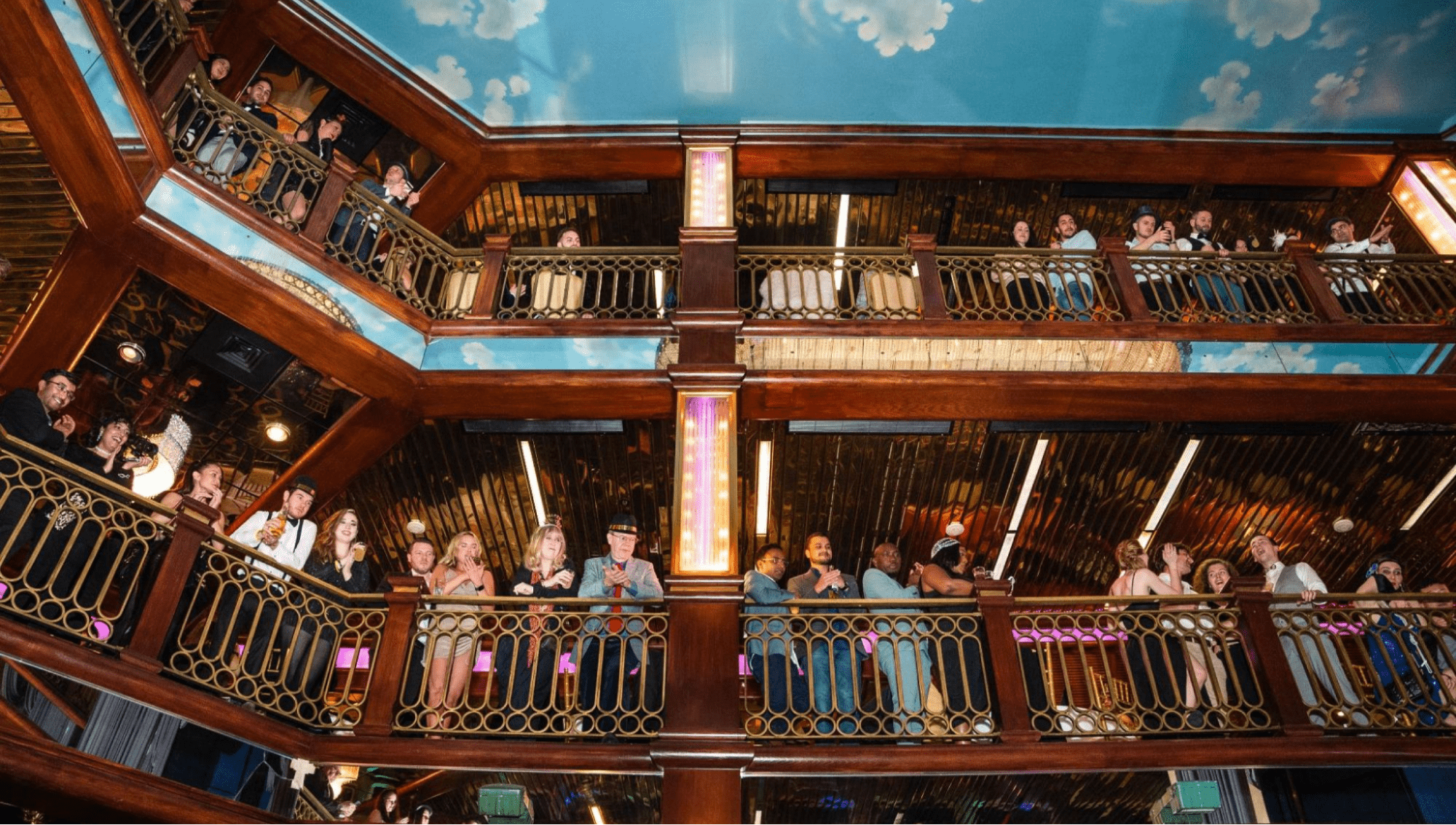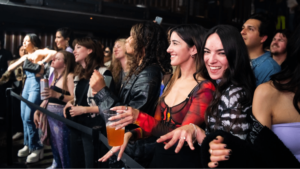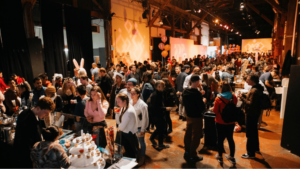Hot take, folks, but venue marketing? Waaaaay more complex than promoting a one-off event—and here’s why.
With standalone events, your mission is clear: sell tickets, build hype, get people through the door. Your audience is defined. Your message, focused.
But venue marketing? Whole. Different. Beast.
You’re not just promoting an event anymore—you’re selling a culture, a vibe, a promise that every time an attendee walks into your space, they’ll have a transformative experience (something 72% of event-goers say they value).
To get more clarity on what actually works, I talked with seasoned pro, Matthew Brooks, Venue Nightlife Manager and Talent Buyer at The Promontory.
The Promontory is a multipurpose venue in the Hyde Park neighborhood of Chicago. It serves as a concert venue and nightclub, known for hosting a diverse range of live music performances, DJ sets, festivals, and cultural events. It’s a popular destination for both local and touring artists, offering a mix of music genres including jazz, hip-hop, R&B, and Afrobeats.
Matthew shared insights on how he and his team structure their venue marketing strategy and measure success. Based on his advice, I’ve put together a guide covering everything you need to know, with real-world examples and actionable tips so you can master your venue marketing (while keeping your sanity in check).
1. Create a sense of community on social media
According to Matthew, “having an engaged audience helps keep the venue packed. Creating a sense of community where guests are always looking for the next event or concert is important.”
Look, if there's one thing The Promontory knows how to do well, it’s build a community around their venue. So, if Matthew says it works—I’d listen. On Insta, they’ve gained around 30k followers, and on Eventbrite they’re doing even better, with 31k followers.
But what’s even more impressive is the kind of engagement they get. On Insta you’ll see past attendees tagging their friends in live event photos, dropping fire emojis on posts about upcoming gigs, and showing up for artists in the comments.
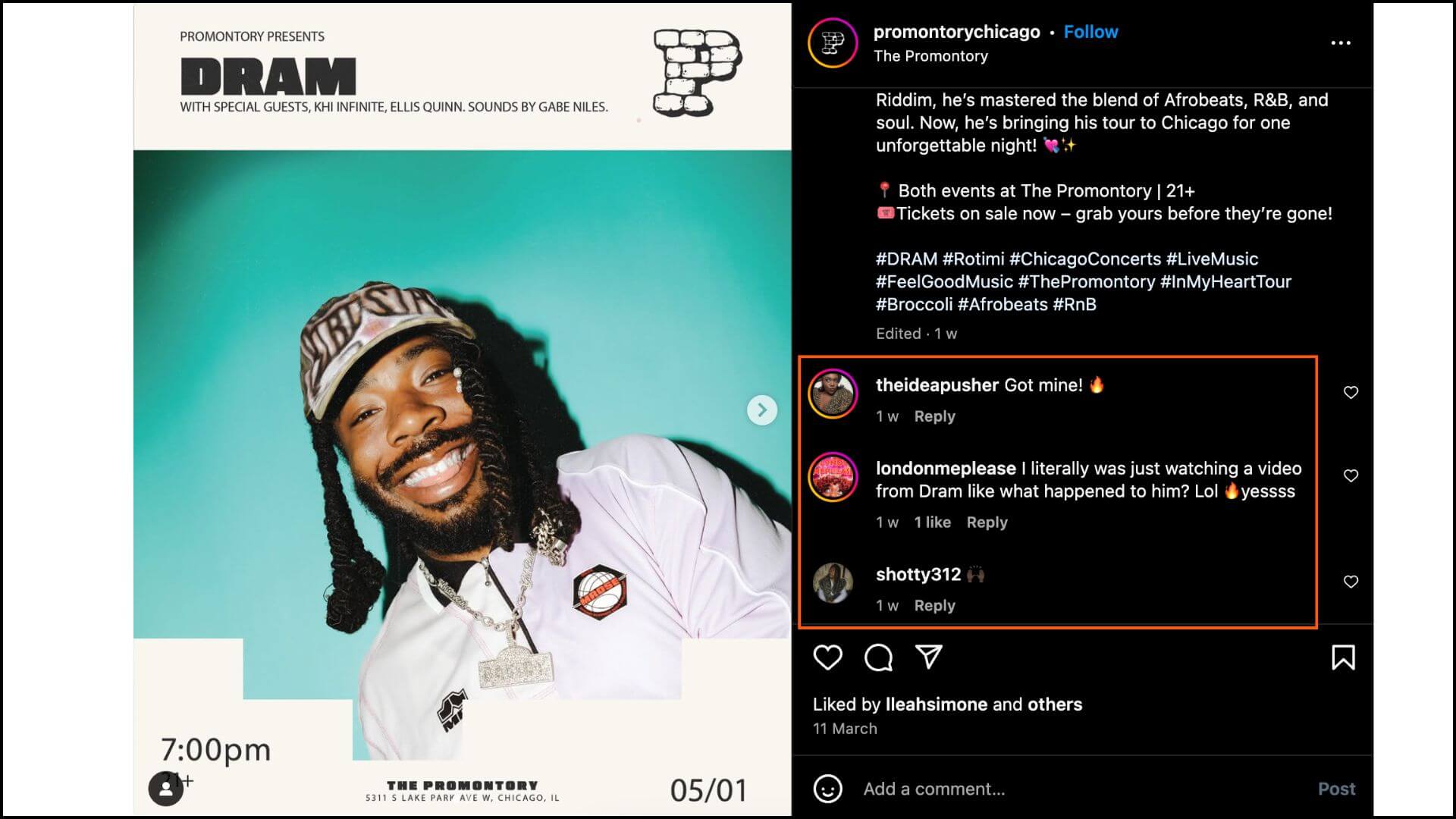
It really does feel like a digital hangout spot for South Siders who want to keep Chicago’s musical heritage alive. And honestly? The energy is kind of infectious.
So, what are they getting right? Well, for starters, their social presence isn’t just about promoting events.
The Promontory is known as a “neighborhood destination that honors Hyde Park’s musical legacy and community spirit.” And that’s exactly what you’ll find on their feed—live event photos that put you on the ground of their infamous second-floor nightclub and “if you know, you know” nods to the local Chicago music scene.
It’s like what Myron Chandran from Afro Soca Love shared during our RECONVENE Session: How I Built My Community From The Ground Up. Creating an intimate, almost 1:1 relationship with your audience—that’s the secret to turning followers into a community.
To approach social media marketing “The Promontory way,” Matthew suggests creating content like:
- Reels and fun stories: Shoot footage of your live shows from your audience’s POV and then turn it into YouTube, Instagram, and Facebook reels.
Leave in those “filming mistakes” you’d normally edit out, like people walking in front of the camera—it’ll give attendees a taste (or regular’s a reminder) of what it feels like to be in your venue,
For example, take a look at how The Promontory shared the reel below (doesn’t that enthusiastic yell from the crowd make you want to visit their venue like right now).
Oh, and also, Insta loves reels under 90 seconds, so don’t be afraid to keep it short and sweet (aim for 10-20 seconds.)
- Live content from the venue: Fill your grid with live event photos—no, seriously. I mean it. Each snapshot should feel like a captured moment in time. I’m talking, close-ups of the artists on stage, sneaky behind-the-scenes long-shots, and bird-eye view drone footage of your attendees lining up out the door.
Another trick you can take from The Promontory is sharing live content from collaborators onto your Insta feed, like posts from artists or event organizers (take a look at this one from Khari Ennu—the comment section is on fire).
- Relatable posts: Post funny and relatable content to show potential attendees that your venue is more than just a pretty face. Think TikTok videos of your artists attempting the latest TikTok dance trend, or chaotic “before-and-after transition” Insta stories documenting your venue setup.
You could even create a YouTube series, like “Horrorshow Hospo Homies” where your bar management crew share their favorite cringe story of the week. I mean, if the series catches on, it’d be a fabulous place to promote your drink menu and offer promo codes.
💡Pro tip: Research shows that creating an emotional connection with your audience is the most important factor in a successful branding strategy. So, when creating social content, remember, you’re not just promoting an experience—you’re selling an emotion.
For example, look at Stereo Live Houston. They don’t dilute their branding by trying to cater to everyone’s tastes. Instead, they use their “high-energy party vibes” as a way of funneling out people who aren’t their target audience.
2. Treat targeted ads and paid online campaigns as a testing ground
When it comes to paid campaigns, Matthew’s advice was refreshingly straightforward: embrace experimentation and get comfortable with the idea that you’re never going to be able to fully predict what works.
“It’s always a constant test till you get it right… some parts of it are always a work in progress.”
There is some good news though: if you’ve already got a solid bank of data from past ad campaigns, then you’re in a very good position (yes, even if those campaigns were a total disaster).
The reason why is because you can said data to understand what’s resonating with your audience and then build a bigger (and better) ad campaign around those insights.
Here’s how you do it:
1. Gather and organize your data: Start by pulling in all the data from your ad campaigns across different platforms. If you’re comfortable with Excel, export your raw stats from Google Analytics, and each of the social platforms you’re using.
Then, categorize the data by key factors, like audience segments, ad creatives, or traffic sources so you can spot trends more easily.
If you’re not a huge spreadsheet fan, that’s fine, just do what I do and take the “cheats way out” (aka get Eventbrite to sort your data out for you—I’ll explain more on this later).
2. Ask specific questions: Once you have your data in front of you, write down 5-10 “focus questions” that’ll help you analyze it from different perspectives and draw out actionable insights.
For instance, a question like: “which platform is generating the most ticket sales?” is perfect because it’s going to help you understand how your audience is interacting with your ads.
3. Take a closer look at what your data’s telling you: Let’s say your ads keep getting tons of impressions but they still have a very low click-through rate. Well, then take the hint—they’re probably a wee bit ugly (kidding, but seriously, it is a sign that something in your ad is turning potential attendees off).
Look at the ad from your audience’s POV—does the live event photo you’re using really capture the action? Could your call-to-action be punchier?
The goal is to find patterns in your data that’ll help you make informed decisions so you don’t have to guess your way through.
Duncan Wold, our customer success manager here at Eventbrite, has a super helpful tutorial on how to ask “the right questions” to analyze your Eventbrite data. I’ll leave the link below so you can check it out if you want more detail on how to make your data work for you.
Okay, so we’ve covered what to do in the case where you have previous data, but what if you don’t? Or what if you do but it isn't pointing to any tangible insights?
Well, then your best bet is to go wide.
Do as Matthew says and start experimenting—run campaigns on different platforms, try various types of ads, and see what resonates with your audience.
For example, get your event listing sponsored with Eventbrite Ads.
The way our algorithm works is that if someone’s searching a certain keyword, we’ll take into account what events are within a 50-mile radius of their location, as well as their search history so we can present them with options we think they’ll love.
What does this mean for you? Well, it’s a great opportunity to get your event in front of people who are the most likely to actually attend and see how it performs.
For instance, when I looked for “jazz performance” in New York, guess what came up first? A sponsored listing from Jorei Jazz & Company’s Free Live Jazz Jam.

💡Pro tip: Matthew recommends taking a proactive approach to data management.
“Everyone can run ads but you need to be measuring your results on a 2-3 day basis and making sure your media/ad content is proving effective to reach the market. Sometimes what worked before may not work again so it is a matter of always being creative and readjusting. Big budget or not—ads are not ‘one size fits all.’”
With Eventbrite, you can track all your ad campaigns in one place (we integrate with TikTok, Instagram, and Facebook) and get real-time insights into how they’re performing. For instance, you can track when people are buying the most tickets for your event.
We show you when your audience is most active (early-bird or last-minute buyers) and help you decide when to focus your ad spend. For instance, if you notice a spike in early-bird sales, you’ll know the best time to ramp up your marketing is 2-3 weeks before the event.
Get data insights with Eventbrite
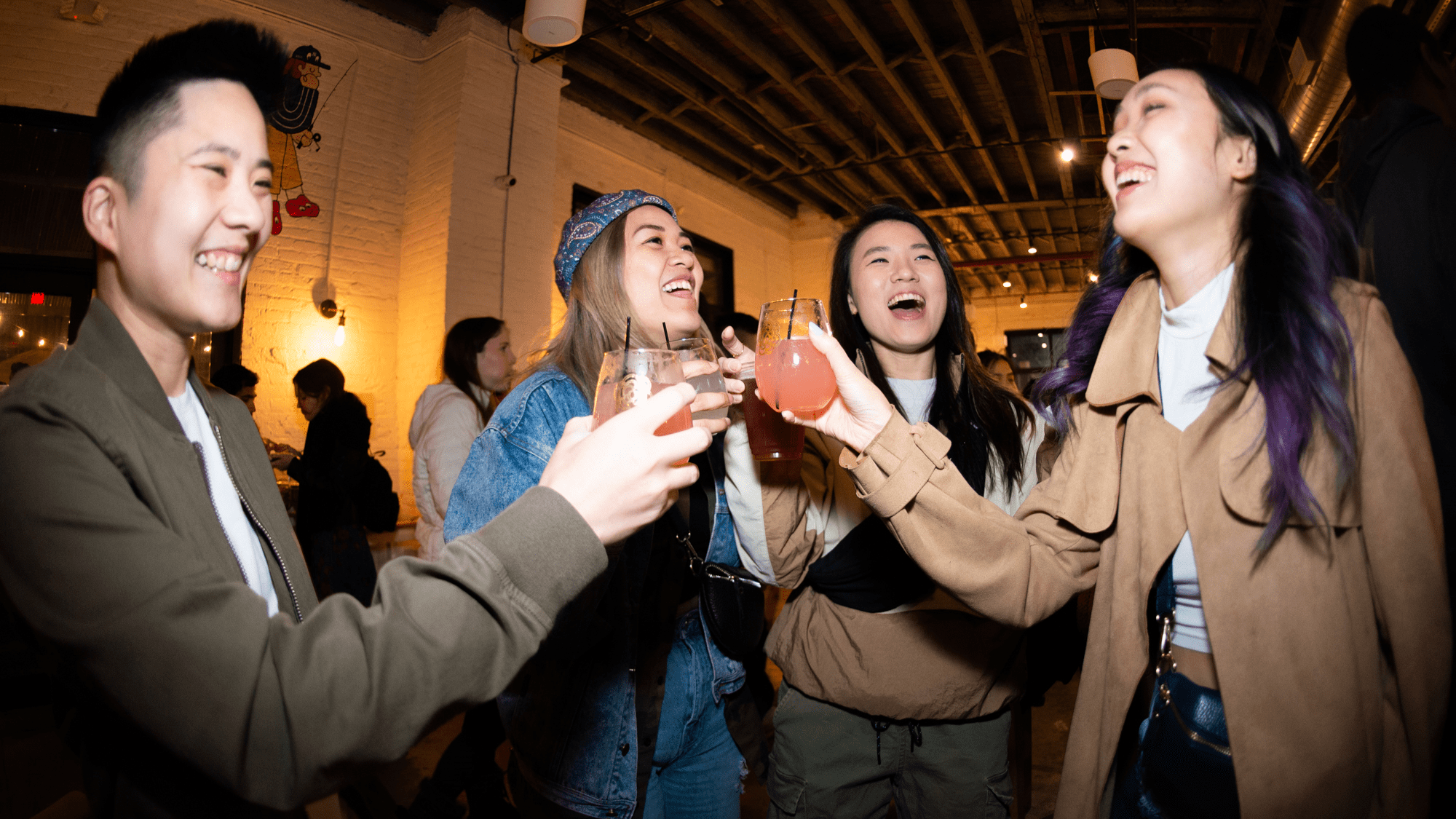
3. Experiment with themed and concept events
One of the things that makes The Promontory “The Promontory” is how much variety they offer in their weekly event lineup. One night they’ll host an Intonation Spring Showcase, and the next they’ll treat their attendees to a performance from Isaiah Collier (no seriously, take a look at their calendar for April—it’s wild).

While Matthew admits that “the identity of being a music venue and nightclub can be challenging at times”, it also gives his team a lot of flexibility to experiment with the type of artists they book and event themes they choose.
“Your audience’s attention is valuable—and easily lost—so it’s crucial to keep them entertained with a diverse range of musical shows and events. From interactive karaoke nights to classic movie screenings, every experience counts. The key is to deliver unforgettable moments that keep guests coming back for more.”
According to Matthew, the secret is to “listen to your audience—they’ll tell you exactly what it takes to keep them coming back.”
During our How I Stand Out During The Holidays Reconvene Session, Kae Burke, co-founder and creative director of House of Yes, said the same thing. She explained that running a “temperature read” of your community can help you find out where your audience is “at” so that you can tailor your approach to meet their needs and desires.
Here’s how you do it:
1. Utilize a daily manager report (DMR): Ask each venue management head to run a DMR so that you can gauge walk-ups, ticket sales, and how much traffic there is at the bar and in the food area. Then, spend time looking for signs of interest.
For instance, do attendees spend more money at the bar when you’re hosting a fully immersive event? Which themes are driving the highest door sales? This will give you a good indication of what kind of event your audiences are looking for.
2. Host a “think-tank” session with your team: Gather your team for a brainstorming session. Kae likes to sit around a table with her inner circle and bounce ideas for events themes. Then, they use a “cool meter” to gauge which ideas they themselves would find fresh and exciting.
For instance, during their Thanksgiving event think tank, they came up with the concept of “It’s Giving.” The team found it funny—so they ran with it.
3. Reinvent the wheel: Use Eventbrite’s discovery page to see what kind of event themes are trending at venues in your local area. Then, take that idea and turn it into something entirely different.
So, let’s say “end of the world” parties are so in right now. Instead of going for the typical walking-dead-brain-eating-zombie theme, host a “Post-Apocalypdo Disco” and turn your venue into a neon-lit wasteland. It’s still “end-of-the-world,” but now it’s got edge.
The other way you can approach it is to find out what’s trending in the world of events and develop unique event concepts around that.
For instance, in our TRNDS report 2025, we found that Chappel Roan-themed events sold more than 28k paid tickets on Eventbrite in 2024, and retro-decade events celebrating the 60s, 70s, 80s and 90s sold 8.5% more paid tickets.
So, you could try creating an event concept, like “I Beg Your Dearest PARTON: Chappel Roan v Dolly Parton”—a night of big hair and bigger emotions, with country-glam decor, and a dance floor full of glitter tears that’s equal parts drama, denim, and disco ball.
💡Pro tip: Pre-sell tickets ahead of time to poll who’s interested in your event. Sana Javeri Kadri, founder of Diaspora Co, explains that she uses Eventbrite’s early bird registration feature to get a feel for how many people are interested in an event.
“We have pre-orders and pre-sell tickets for absolutely everything, so if only three tickets sell well you know to not host the event… whereas we have other events where we have 600 RSPVs.”
Find out how early bird registration works
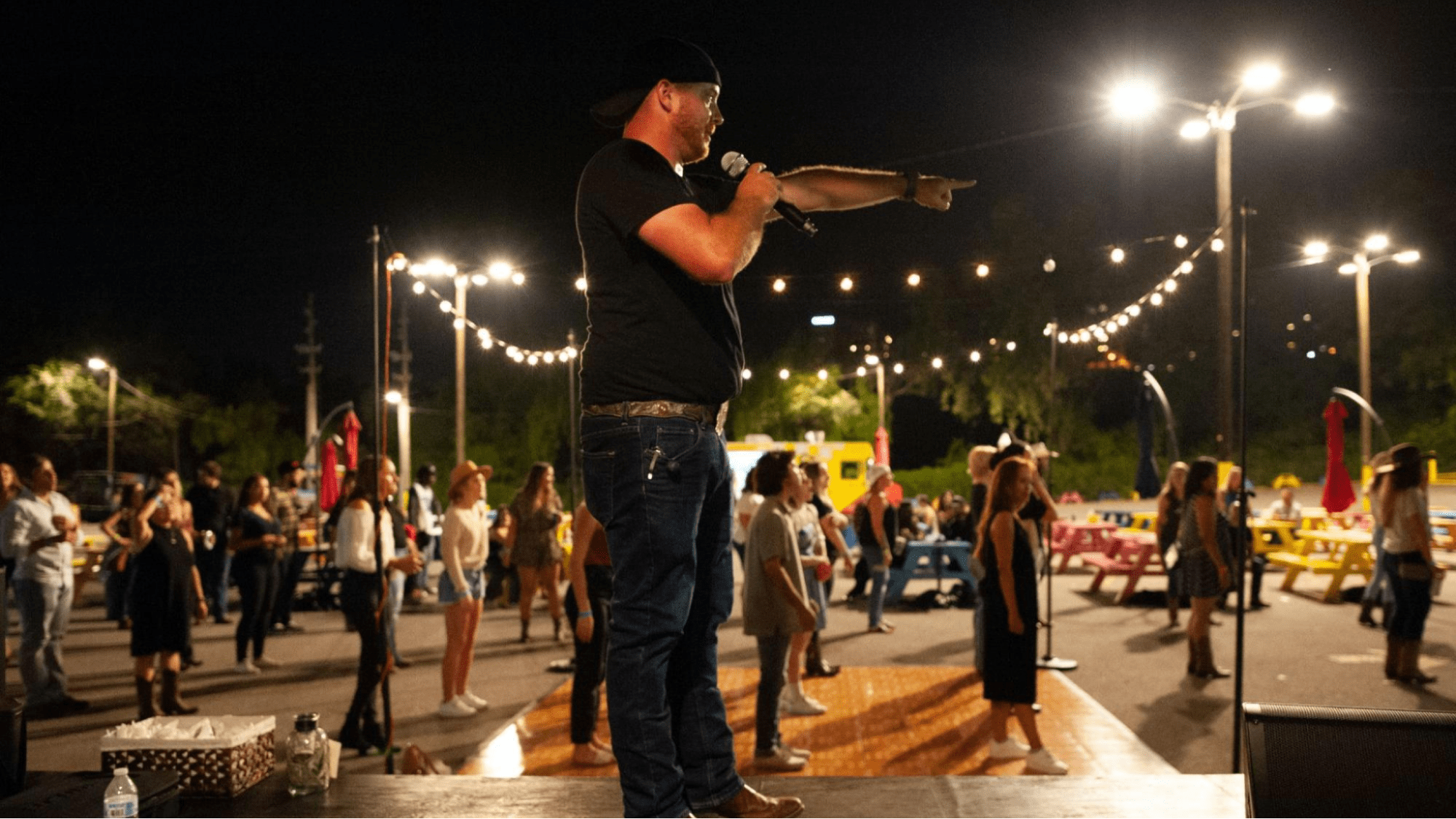
4. Build an email marketing campaign
Yep. Even in 2025, email marketing is still one of the most reliable ways to reach your target audience and turn potential attendees into paying customers. In fact, for every $1 spent on email marketing, you can expect an average return of $40.
The trick is to make your attendees feel as though joining your email is the same thing as getting invited into an exclusive club.
How do you do this, you ask? Add value to their lives.
Create entertaining content, offer exclusive discounts, and show up consistently, but not all the time—aim for “friend who’s very enthusiastic about sharing cool stuff”, not “Nigerian-prince-looking-for-a-wife” (if you see what I mean).
These are some strategies you can use to build a killer email marketing campaign:
- Create a weekly newsletter: Publish a weekly newsletter about things that your target audience would find interesting based on the nature of your events. For instance, take a look at Ash Rides London weekly substack email.
She doesn't just talk about her cycle classes—she taps into her audience’s love for inclusive, interactive experiences by sharing things like handpicked music playlists, insider tips on cycling form, and behind-the-scenes peeks into what makes her classes unique.

- Make it personal: Mailchimp says that 71% of customers are more likely to purchase from companies that send personalized emails. So, give the people what they want. Address your attendees by their first name, include “inside jokes” in your opening line, and use familiar language throughout, like “guys” and “folks”.
And most importantly, let your enthusiasm for your venue come through. Ask yourself: Why do I love my venue? Then use that to craft engaging email copy. Here’s a good example of the type of tone I’m talking about:
“Guys! We’re hosting ANOTHER Boiler Room event and it’s going to be lit. We know a few of you missed out last time, so we’re offering a 15% discount to our loyal regulars before midnight tonight (you’re welcome 😉). Can’t wait to see you all next week—don’t forget to bring comfortable shoes for the midnight set!”
- Offer exclusive discounts: Provide discounts that reward loyalty, such as early access to tickets, free entry to select events, and other members-only perks to help build loyalty to your venue.
Make your audience feel special by using phrases like “priority access” and “exclusive offer.” Highlight that they’re receiving VIP treatment that “standard” attendees (aka those peasants who aren’t on your email list) miss out on.
💡Pro tip: When you team up with Eventbrite, you get access to our “intelligent audience targeting” tool, which helps you automatically segment your email list.
This means you can create email campaigns that speak directly to where your audience is at. For example, you can target people who’ve already bought tickets and send them event updates, while offering special offers to those who signed up for your newsletter but haven’t bought tickets yet.
Plus, we also give you access to our tried-and-proven email templates and an AI writing assistant that’ll help you create and send emails faster (with +59% higher open rates than the industry average).
Level up your email marketing with Eventbrite

5. Incentivize your audience with activations and giveaways
As Matthew says, “Guests love free stuff! Give them something to remember or trigger good feelings. The goal is to try to incentivize them as much as possible and they will continue to patronize you.”
And that makes a lot of sense, doesn’t it?
If you show attendees that they’ll be appreciated (and rewarded) for their time, money, and loyalty every time they come to your venue, then they’ll keep coming back, because well—why wouldn’t they?
The best way to prove your worth is to offer experiences that extend way beyond the value of a general admission ticket. That might mean allowing for free entry before 11.30pm (like The Promontory offered for their Anything Goes event) or using Eventbrite’s new “2 for 1” ticket types to let attendees bring a friend for free.
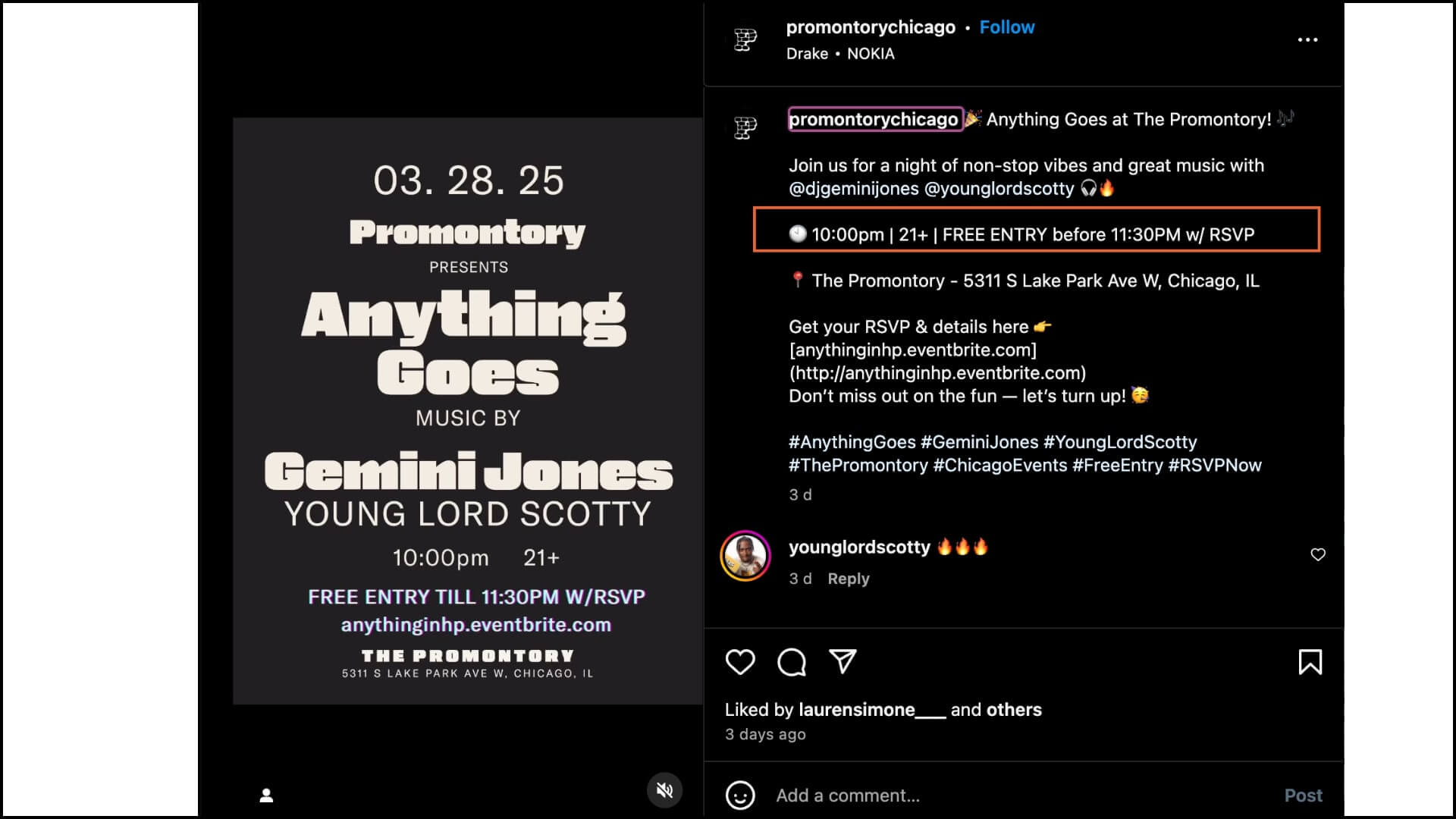
Sure, you have to give a little, but you’re getting a whole lot in return. Recurring attendees? Yep. Brand loyalty? Absolutely. And on top of that, you’re setting yourself up for some good ol’ fashioned word-of-mouth marketing—something you definitely want to do considering that we found out 47% of consumers still discover events this way.
Matthew also suggested a few strategies that you can use, such as:
- Sponsored giveaways: Reach out to your event partners, any local businesses that correlate with your venue (think body glitter stores for nightclub events or neighboring bars for restaurants) and event sponsors and see about collaborating on giveaways.
For example, look at what Into The Streets is offering for their Downtown First Thursdays event.
Attendees who RSVP within an hour are getting a LOT of extra value—10% off with Cannavine, a local cannabis store (which is perfect considering they’re known for hosting wild parties) along with discounts on food and drinks at their venue.
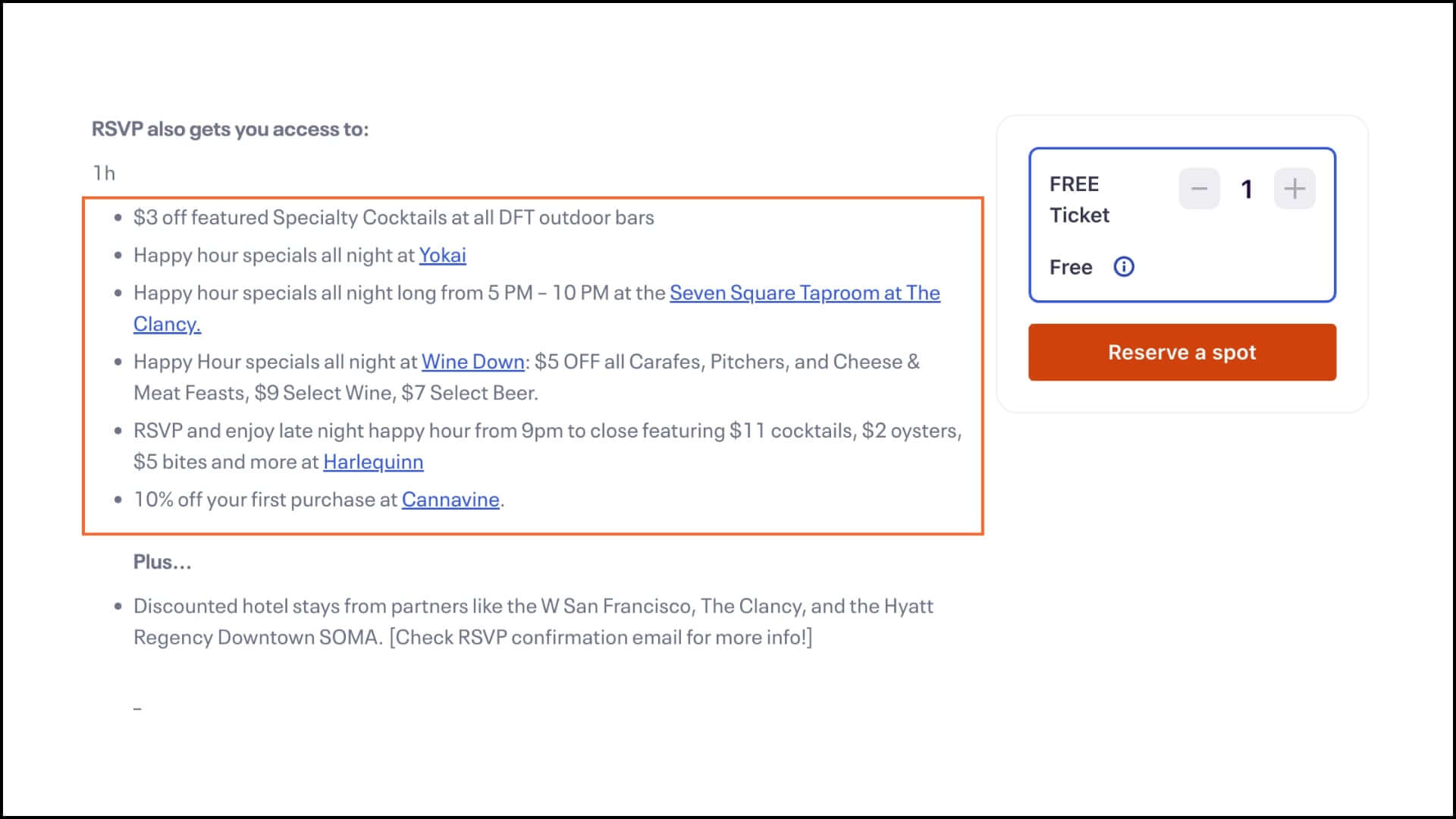
- Cool merch: Throw in an item of merch as part of your VIP deals. Or, host a social media contest, like a sweepstakes, and give it away as the prize.
Keep in mind that in our TRNDS report 2025, we found that 41% of 21- to 35-year-olds would be enticed by different or unusual merch to commemorate a special experience. So, if you’re committing to offering merch—you better make sure it’s distinctive and on-brand.
For example, Elsewhere’s t-shirt collection perfectly encapsulates what makes their brand stand out—it’s all indie kid vibes with a hint of a grungy attitude.
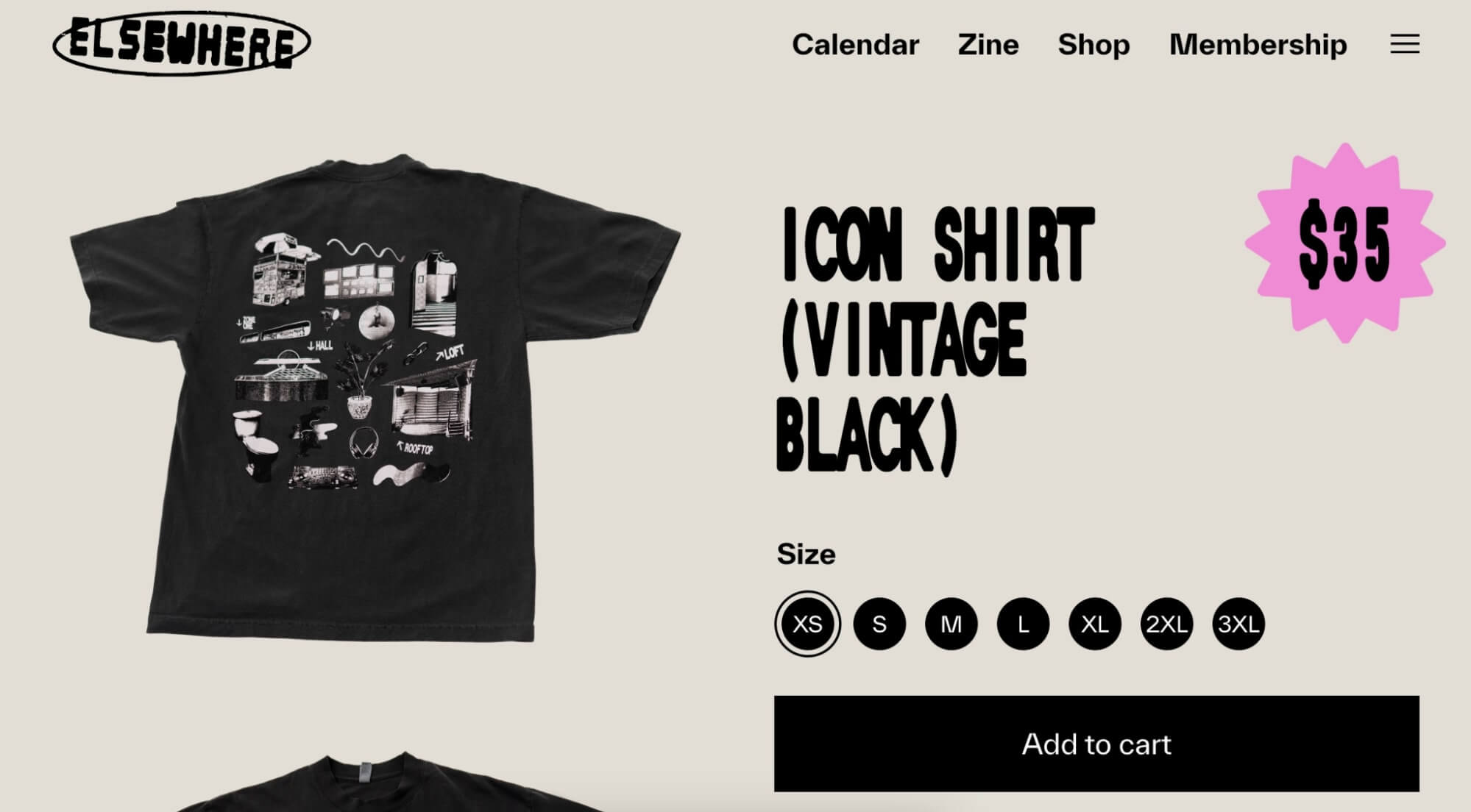
- Complimentary samples: Give your attendees a taste of what’s on the menu at your venue. If you’re a multi-use venue like The Promontory, with a full restaurant attached to your event space, then use that to your advantage. Offer bite-sized samples of your newest or most popular dishes with each drink order.
Or, if you’re just a licensed venue, then hand out a mini sampler of your signature cocktail to the first 50 attendees who arrive. - Installations: We found that 76% of attendees would be willing to pay a higher price to attend a tech-enabled event. So, offer attendees a fully immersive experience.
Think interactive elements, like holographic mapping, augmented reality, or reactive lighting that moves over the crowd (I saw Avant Gardner, LLC use this technique—and yes, it really is as cool as it sounds).
For example, in our Music and Nightlife Trends Report Eric Woo, co-founder of WAO Superclub, told us that they “installed an AI-inspired head from the ceiling… it’s mirrored on all sides and the reflective surface plays around with the lights that hit the head, and also the lasers and smoke creates a unique experience.”
💡Pro tip: Think of an exclusive experience that you can offer attendees as a bonus perk. For example, during our Tales of Failure: How I Messed Up and What I Learned with Harry Weil from The Green-Wood Cemetery, he shared that instead of giving out a physical gift, they offer private tours of the cemetery that attendees can redeem any time—and they can even bring up to 40 guests with them.
6. Increase your visibility on Google
Marketing your venue on Google goes beyond using paid search or display ads. It’s an opportunity to showcase your reputation to your community and establish credibility within the events industry.
In order to achieve this, you want to lock down your website’s search engine optimization (SEO) and analyze what ranks in the top 10 search positions when someone searches for relevant keywords.
For example, if you’re a venue that features rock artists, then you’d want to include keywords like “rock music venue” and “live rock concerts” on your site, as well as the names of any popular artists you’ve hosted.
When optimizing your venue’s presence on Google, consider questions like:
- Are there featured customer reviews from reputable sources such as Tripadvisor, and are these positive or negative?
- Is my venue easy to locate on the first page of Google?
- Are there any negative articles or reviews that need to be addressed?
💡Pro tip: When you create an event listing on Eventbrite, it’s already SEO-optimized to rank higher on Google search engines. With built-in event schema, structured URLs, and meta tags, your event page is easy for search engines to find and index—no extra effort needed. Just fill in your details, hit publish, and let Eventbrite’s SEO do the work for you.
Did venue marketing just become fun?
As it turns out what makes venue promotion so overwhelming is also what makes it oh-so-very-exciting: it’s about trial-and-error.
So, your first call of order? Take the pressure off yourself to know exactly what works, and instead focus on learning, and adjusting as you go. As Matthew says, “Be proactive and push the limits of your creativity—don’t shy away from experimenting and trying again.”
At the end of the day, the only place you should be looking for answers on what works with your community is… your community. They’ll let you know what they’re craving through their purchases, booking patterns, and social media engagement.Luckily, when it comes to analyzing your audience and event data, you’ve got us on your side.
When you partner with Eventbrite, you get real-time updates delivered straight to your dashboard. You can track everything from how many attendees showed up to specific themed events over the past 12 months, to your best-sellers on “add-ons” like merch or VIP upgrades, and even which social media and email campaigns are driving real results.
